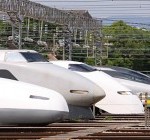E-Trains and Energy Storage
 One of the most promising aspects of energy storage is that it’s used to make an existing system more efficient. If you think of the grid as the system, then energy storage can help make generation, transmission, distribution, and even customer energy use more efficient.
One of the most promising aspects of energy storage is that it’s used to make an existing system more efficient. If you think of the grid as the system, then energy storage can help make generation, transmission, distribution, and even customer energy use more efficient.How many different systems are there? The grid is the most obvious example. Microgrids are another type of system. A more relevant system to the average consumer is a transportation system. And there are several examples of companies in the energy storage space targeting transportation systems.
How does it work? An energy storage system (specifically, a battery) is paired with an electricity-powered train system; the battery captures the energy from regenerative braking, just as the battery in a hybrid-electric vehicle does (which is part of the reason why these vehicles have high gas mileage). In the case of transportation systems, the battery is situated not on the train itself, but at a station the train travels through.
Hitachi is supplying two 1 megawatt lithium ion battery systems to the Seoul Metro in Korea, after successfully trialing what the company calls the B-CHOP system in a train station in Kobe, Japan. In this case, the batteries will collect energy from passing (and braking) trains and use that energy to run other electric trains on the system. The goal is to reduce the overall energy consumption of the electric trains passing through the station.
NGK Insulators has also installed several sodium sulfur battery systems at rail stations in Japan, although it is not clear whether these systems are being used to capture energy from the braking trains themselves, or to manage how much the stations and trains are taxing the grid. A subtle difference in applications, but an important one.
SEPTA (Philadelphia) is testing a battery from SAFT at a busy rail station and is using it to store and release energy. The transport agency is also partnering with Viridity Energy (also based in Philadelphia) to participate in demand response programs and the and frequency regulation market. Thankfully for SEPTA, PJM Interconnection – the independent system operator for the region – is one of the most progressive system operators in the country and allows even relatively small assets (like a modestly sized battery) to participate in the frequency regulation market. Programs like these could make railways and urban transit systems even more efficient ways of transporting large numbers of people.
You can return to the main Market News page, or press the Back button on your browser.

